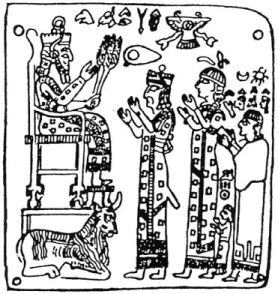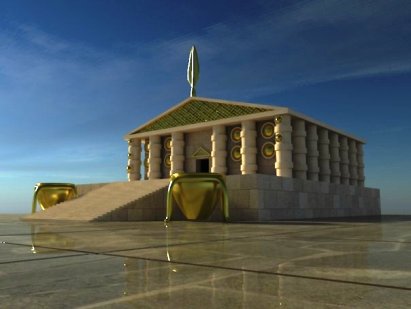|
Ishpuini
Ishpuini (also Ishpuinis) () was king of Urartu. He succeeded his father, Sarduri I, who moved the capital to Tushpa (Van). Ishpuini conquered the Mannaean city of Musasir, which was then made the religious center of the empire. The main temple for the war god Haldi was in Musasir. Ishpuini's kingdom was then attacked by the forces of the Assyrian King Shamshi-Adad V. Ishpuini fought and defeated Shamshi-Adad. Ishpuini was so confident in his power that he began using names meaning everlasting glory, including, "King of the land of Nairi", "Glorious King", and "King of the Universe". Ishpuini was succeeded by his son, Menua. Apart from the Kepenek Castle inscription, another inscription proving the existence of the Urartian Kingdom in the geography of Muş is the Alazlı/Tirmet inscription. The inscription in question is located 25.5 km east of Muş province and 6.2 km south of Korkut district. In the inscription, the war fought by the Urartian king Menua is mentioned: ... [...More Info...] [...Related Items...] OR: [Wikipedia] [Google] [Baidu] |
List Of Kings Of Urartu
This article lists the kings of Urartu (Ararat or Kingdom of Van), an Iron Age kingdom centered on Lake Van in eastern Asia Minor. Kings See also *List of Mesopotamian dynasties References *Boris Piotrovskii, ''The Ancient Civilization of Urartu'', London, 1969. *Igor Diakonoff, ''The Pre-History of the Armenian People'', Caravan Books, New York, 1988. *M. Chahin, ''The Kingdom of Armenia'', Curzon, London, 2001. External links Urartu {{DEFAULTSORT:Kings of Urartu Kings of Urartu, Lists of monarchs in Asia, Urartu ... [...More Info...] [...Related Items...] OR: [Wikipedia] [Google] [Baidu] |
Menua
Menua ( ariations exist, also rendered Meinua or Minua, was the fifth known king of Urartu from c. 810 BC to approximately 786 BC. In Armenian, Menua is rendered as ''Menua''. The name Menua may be connected etymologically to the Ancient Greek names Minos and Minyas. A younger son of the preceding Urartian King, Ishpuini, Menua was adopted as co-ruler by his father in the last years of his reign. Menua enlarged the kingdom through numerous wars against the neighbouring countries and left many inscriptions across the region, by far the most of any Urartian ruler. He organized a centralised administrative structure, fortified a number of towns and constructed fortresses. Amongst these was Menuakhinili located near Mount Ararat (its exact location is uncertain, perhaps at Bulakbaşı, east of modern-day Iğdır). He briefly co-ruled with his son, Inushpua, but was succeeded by another son, Argishti I. Menua also had a daughter named Tariria, after whom a certain vineyard was n ... [...More Info...] [...Related Items...] OR: [Wikipedia] [Google] [Baidu] |
Urartu
Urartu was an Iron Age kingdom centered around the Armenian highlands between Lake Van, Lake Urmia, and Lake Sevan. The territory of the ancient kingdom of Urartu extended over the modern frontiers of Turkey, Iran, Iraq, and Armenia.Kleiss, Wolfram (2008). "URARTU IN IRAN". ''Encyclopædia Iranica''. Its kings left behind cuneiform inscriptions in the Urartian language, a member of the Hurro-Urartian languages, Hurro-Urartian language family. Urartu extended from the Euphrates in the west to the region west of Ardabil in Iran, and from Lake Çıldır near Ardahan in Turkey to the region of Rawandiz in Iraqi Kurdistan. The kingdom emerged in the mid-9th century BC and dominated the Armenian Highlands in the 8th and 7th centuries BC. Urartu frequently warred with Neo-Assyrian Empire, Assyria and became, for a time, the most powerful state in the Near East. Weakened by constant conflict, it was eventually conquered, either by the Iranian peoples, Iranian Medes in the early 6th c ... [...More Info...] [...Related Items...] OR: [Wikipedia] [Google] [Baidu] |
Sarduri I
Sarduri I (ruled: 834 BC – 828 BC), also known as Sarduris, Sedur, and Asiduri, was king of Urartu. He was known as Ishtarduri to the Assyrians. It is unclear whether Sarduri's father, Lutipri, was a king of Urartu. It is possible that Lutipri was not a king and that Sarduri established a new dynasty. Sarduri I is most known for moving the capital of the Urartu kingdom to Tushpa (Van). This proved to be significant as Tushpa became the focal point of politics in the Near East. His kingdom was influenced by the Neo-Assyrian Empire through architecture, royal titles, and the usage of Akkadian language Akkadian ( ; )John Huehnergard & Christopher Woods, "Akkadian and Eblaite", ''The Cambridge Encyclopedia of the World's Ancient Languages''. Ed. Roger D. Woodard (2004, Cambridge) Pages 218–280 was an East Semitic language that is attested ... in early Urartian inscriptions. He was succeeded by his son, Ishpuini of Urartu, who then expanded the kingdom. The title Sa ... [...More Info...] [...Related Items...] OR: [Wikipedia] [Google] [Baidu] |
Musasir
Muṣaṣir (Assyrian cuneiform: and variants, including Mutsatsir, Akkadian for ''Exit of the Serpent/Snake''), in Urartian Ardini was an ancient city of Urartu, attested in Assyrian sources of the 9th and 8th centuries BC. It was acquired by the Urartian King Ishpuini ca. 800 BC (see the Kelashin Stele). The city's tutelary deity was dḪaldi. The city's location is not known with certainty, although there are a number of hypotheses, all in the general area of , in the Zagros south of Lake Urmia. François Thureau-Dangin tentatively located it at Mudjesir, 10 km west of Topzawa. Reza Heidari, an archaeologist of the "Cultural Heritage and Tourism Organization" of Iran's West Azarbaijan Province claims Rabat city near Sardasht, Iran as the location of Muṣaṣir. H. F. B. Lynch claimed that it was close to the modern town of Rawandiz in Iraqi Kurdistan. Urartologist Paul Zimansky speculated that the Urartians (or at least the ruling family) may have emigrated ... [...More Info...] [...Related Items...] OR: [Wikipedia] [Google] [Baidu] |
Ḫaldi
Ḫaldi (dingir, d,''Ḫaldi'', also known as Khaldi) was one of the three chief deities of Urartu (Urarat/Ararat Kingdom) along with Teisheba and Shivini. He was a warrior god to whom the kings of Urartu would pray for victories in battle. Ḫaldi was portrayed as a man with or without wings, standing on a lion. His principle shrine was at Ardini (Muṣaṣir). The temples dedicated to Khaldi were adorned with weapons such as swords, spears, bows and arrows, and shields hung from the walls and were sometimes known as "the house of weapons". History According to Urartologist Paul Zimansky, Haldi was not a native Urartian god but apparently an obscure Akkadian Empire, Akkadian deity (which explains the location of the main temple of worship for Haldi in Musasir, believed to be near modern Rawandiz, Rawandiz, Iraq). Haldi was not initially worshipped by Urartians, at least as their chief god, as his cult does not appear to have been introduced until the reign of Ishpuini of Ura ... [...More Info...] [...Related Items...] OR: [Wikipedia] [Google] [Baidu] |
Mannaea
Mannaea (, sometimes written as Mannea; Akkadian: ''Mannai'', Biblical Hebrew: ''Minni'', (מנּי)) was an ancient kingdom located in northwestern Iran, south of Lake Urmia, around the 10th to 7th centuries BCE. It neighbored Assyria and Urartu, as well as other small buffer states between the two, such as Musasir and Zikirta. Etymology of name The name of Mannaea and its earliest recorded ruler Udaki were first mentioned in an inscription from the 30th year of the rule of Shalmaneser III (828 BC). The Assyrians usually called Manna the "land of the Mannites", Manash, while the Urartians called it the land of Manna. Describing the march of Salmanasar III in the 16th year (843 BC), it was reported that the king reached the land of Munna, occupying the interior of Zamua. However, the chronicle does not mention any march or taxation on the state of Mannaea. It is possible that the Assyrians either failed to conquer Mannaea, or advanced only to the border of Mannaea, and then c ... [...More Info...] [...Related Items...] OR: [Wikipedia] [Google] [Baidu] |
Tushpa
Tushpa ( ''Tosp'', ''Tushpa-Van'', Akkadian: ''Turuspa'', from Urartianbr>tur-, ''to destroy''i.e. victorious) was the 9th-century BC capital of Urartu, later becoming known as Van which is derived from ''Biainili'', the native name of Urartu. The ancient ruins are located just west of Van and east of Lake Van in the Van Province of Turkey.Tushpa, site information Retrieved 13 June 2023. In 2016 it was inscribed in the Tentative list of World Heritage Sites in Turkey. It was possibly pronounced as "Tospa" in ancient times as there was no symbolic ''O'' equivalent in |
Monarch
A monarch () is a head of stateWebster's II New College Dictionary. "Monarch". Houghton Mifflin. Boston. 2001. p. 707. Life tenure, for life or until abdication, and therefore the head of state of a monarchy. A monarch may exercise the highest authority and power in the Sovereign state, state, or others may wield that power on behalf of the monarch. Usually, a monarch either personally inheritance, inherits the lawful right to exercise the state's sovereign rights (often referred to as ''the throne'' or ''the Crown, the crown'') or is elective monarchy, selected by an established process from a family or cohort eligible to provide the nation's monarch. Alternatively, an individual may self-proclaimed monarchy, proclaim oneself monarch, which may be backed and Legitimacy (political), legitimated through acclamation, right of conquest or a combination of means. If a young child is crowned the monarch, then a regent is often appointed to govern until the monarch reaches the requisi ... [...More Info...] [...Related Items...] OR: [Wikipedia] [Google] [Baidu] |
Assyria
Assyria (Neo-Assyrian cuneiform: , ''māt Aššur'') was a major ancient Mesopotamian civilization that existed as a city-state from the 21st century BC to the 14th century BC and eventually expanded into an empire from the 14th century BC to the 7th century BC. Spanning from the early Bronze Age to the late Iron Age, modern historians typically divide ancient Assyrian history into the Early Assyrian period, Early Assyrian ( 2600–2025 BC), Old Assyrian period, Old Assyrian ( 2025–1364 BC), Middle Assyrian Empire, Middle Assyrian ( 1363–912 BC), Neo-Assyrian Empire, Neo-Assyrian (911–609 BC), and Post-imperial Assyria, post-imperial (609 BC– AD 240) periods, based on political events and gradual changes in language. Assur, the first Assyrian capital, was founded 2600 BC, but there is no evidence that the city was independent until the collapse of the Third Dynasty of Ur, in the 21st century BC, when a line of independent kings starting with Puzur-Ashur I began rulin ... [...More Info...] [...Related Items...] OR: [Wikipedia] [Google] [Baidu] |
Shamshi-Adad V
Shamshi-Adad V () was the King of Assyria from 824 to 811 BC. He was named after the god Adad, who is also known as Hadad. Family Shamshi-Adad was a son and successor of King Shalmaneser III, the husband of Queen Shammuramat (by some identified with the mythical Semiramis), and the father of Adad-nirari III, who succeeded him as king. He was also a grandfather of Shalmaneser IV. Reign The first years of Shamshi-Adad's reign saw a serious struggle for the succession of the aged Shalmaneser. The revolt was led by Shamshi-Adad's brother Assur-danin-pal, and had broken out already by 826 BC. The rebellious brother, according to Shamshi-Adad's own inscriptions, succeeded in bringing to his side 27 important cities, including Nineveh. The rebellion lasted until 820 BC, weakening the Assyrian empire and its ruler; this weakness continued to reverberate in the kingdom until the reforms of Tiglath-Pileser III. Later in his reign, Shamshi-Adad campaigned against Southern Meso ... [...More Info...] [...Related Items...] OR: [Wikipedia] [Google] [Baidu] |




